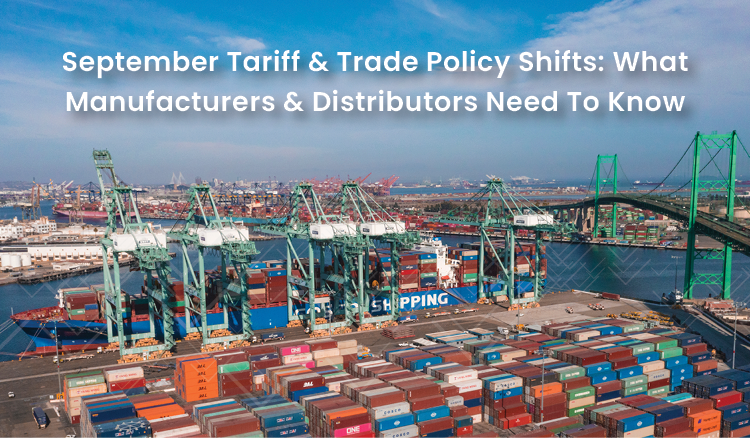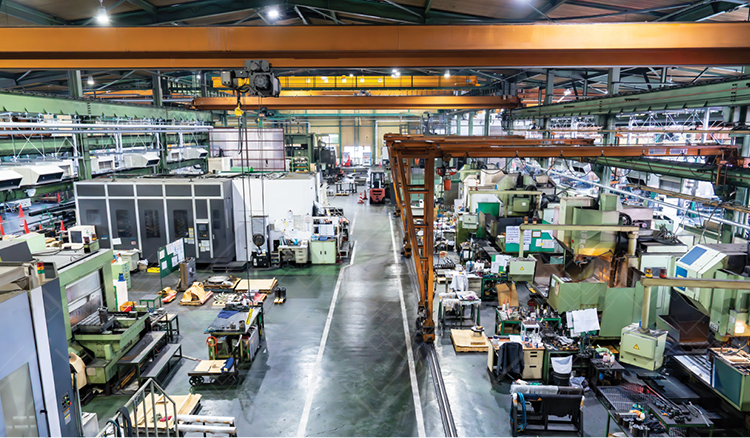Trump 2.0 September Tariff & Trade Recap: Discussing New Tariffs, Plus The Latest Trade Deals and Court Rulings
Global trade has already been reshaped by the sweeping tariffs rolled out earlier this year, but recent announcements only push that reset further. For business leaders, the risks of overseas dependence are now permanent, but so are the opportunities. As imports become more costly, domestic producers that can reshore, adapt quickly, and scale efficiently stand to win market share and strengthen their long-term position.
In the sections that follow, this article provides a brief recap of the most important tariff and trade moves over the month of September and what they mean for manufacturers and distributors navigating today’s volatile environment.
New Tariff Announcements
100% Pharmaceutical Tariff
On Thursday September 25th, President Trump announced that brand-name and patented pharmaceutical products will be subject to a 100% tariff starting October 1st, unless the manufacturer is actively building a U.S. plant. The administration framed the move as both a national security measure and a way to pressure global drugmakers into reshoring production. Unlike previous rounds of tariffs, which largely exempted medicines, this marks a major shift in trade policy. Trump made clear in a Truth Social post that “IS BUILDING” would be defined as breaking ground or being under construction, creating a direct incentive for companies to accelerate U.S. investments.
Notably, the 100% tariff does not apply to generic pharmaceuticals, a carve-out meant to avoid disrupting supply of cost-sensitive medicines. For distributors and healthcare networks, this ensures continued access to lower-priced generics while still pressuring global firms on branded drug production.
For domestic manufacturing, the impact is already visible. Eli Lilly announced a $6.5 billion facility in Houston and a $5 billion site near Richmond, Virginia, part of hundreds of billions in new U.S. pharma investments unveiled this year. Global players like AstraZeneca, Novartis, GSK, and Sanofi have also announced or begun U.S. construction, insulating themselves from the steepest tariffs while creating thousands of American jobs. While industry groups caution that tariffs may not lower drug prices, the practical effect is clear: foreign reliance is shrinking, and the U.S. pharmaceutical base is expanding. For manufacturers and distributors, the opportunity lies in a stronger, more localized supply chain, one better able to withstand global shocks and deliver long-term resilience.
50% Tariff on Kitchen Cabinets and Bathroom Vanities
President Trump also announced a 50% tariff on imported kitchen cabinets, bathroom vanities, and related products, effective October 1st. The administration tied the move to national security considerations, pointing to the Commerce Department’s earlier Section 232 investigation into timber and lumber. While critics warn of inflationary effects, the White House emphasized that tariffs remain a central tool for reducing U.S. dependence on foreign producers and restoring capacity in industries vital to construction and housing.
For American cabinetmakers, this is a significant opening. Imports from Asia, especially China and Vietnam, have long undercut U.S. producers, eroding market share and shuttering plants. Now, with tariffs leveling the field, manufacturers in states like North Carolina, Indiana, and Ohio are poised to benefit. Though near-term costs for builders may rise, the bigger story is the opportunity for U.S. producers to reclaim ground, invest in automation, and strengthen their role in the domestic housing supply chain. For distributors and homebuilders that lean into American-made sourcing, these tariffs can help secure more resilient, predictable supply in a sector that has faced years of volatility.
30% Tariff on Upholstered Furniture
President Trump announced a 30% tariff on upholstered furniture imports, effective October 1st. The move builds on the Commerce Department’s earlier review of timber and lumber, signaling that the administration views furniture manufacturing as a strategic sector. For decades, low-cost imports from Vietnam and China have dominated the U.S. market, decimating domestic producers who once anchored communities in states like North Carolina and Mississippi. By raising import costs, the tariff aims to restore balance and bring jobs back to regions historically tied to furniture making. At the same time, Trump has indicated that details are still forthcoming, hinting that carve-outs, delays, or phased implementation may shape how the tariff ultimately takes effect.
For U.S. manufacturers, the opportunity is significant. Domestic producers that can modernize facilities and scale quickly stand to win back customers from retailers and distributors seeking tariff-proof supply. The policy also provides a buffer against global supply chain disruptions that have plagued the sector in recent years.
25% Tariff on Heavy Trucks
Trump also set a 25% tariff on imported heavy trucks, underscoring the administration’s commitment to protecting U.S. industrial capacity in critical transportation sectors. The tariff is paired with a national security rationale, with Trump noting that domestic truckmakers like Peterbilt, Kenworth, Freightliner, and Mack Trucks must be shielded from foreign competitors.
For U.S. manufacturers and distributors, the impact could be transformative. Domestic truckmakers will be better positioned to expand production without the same cost disadvantages, and several firms have already announced new investments in U.S. assembly lines. The tariffs also create an incentive for further innovation in electric and autonomous trucks, sectors where U.S. leadership is still emerging. For logistics companies and fleet distributors, the near-term adjustments may be challenging, but the long-term outcome is a stronger, more resilient domestic supply chain for heavy-duty transport, critical for construction, defense, and commerce alike.
100% Tariff on Foreign Films
On September 29th, President Trump announced plans to impose a 100% tariff on all movies produced outside the United States. The move, shared via Truth Social, frames foreign films as a strategic threat, accusing other countries of “stealing” America’s creative output and undercutting U.S. production.
For companies in auxiliary industries such as set construction, filming equipment, and distribution, the tariff could distort global sourcing and favor U.S.-based production. Studios may accelerate reshoring of film projects or shift more work to U.S. facilities to avoid tariff exposure, creating secondary opportunities for domestic suppliers in props, lighting, and post-production services. While the policy is still in flux and lacks legal clarity, its announcement signals the administration’s willingness to push tariff boundaries into entirely new sectors.
Recent Trade Deals Now in Force
While tariffs have dominated the headlines, several trade agreements finalized in September are beginning to take effect, reshaping the environment for U.S. manufacturers and distributors. These deals may not grab as much attention as 100% or 50% tariff announcements, but they carry long-term weight by clarifying costs, expanding market access, and reducing uncertainty.
U.S.–Japan Deal Becomes Official
The revised U.S.–Japan trade pact entered into force in mid-September, lowering tariffs on Japanese cars, auto parts, and select consumer goods. In return, Japan expanded its commitments to purchase U.S. agricultural products—including beef, pork, and corn—as well as liquefied natural gas and other energy exports. For U.S. manufacturers and distributors, the deal provides more predictable pricing for critical imports like auto components, which are essential for domestic assembly operations. It also opens new demand channels for American farmers and energy producers, deepening cross-Pacific trade ties at a moment when supply chains are under strain.
U.S.–EU Agreement Locks in Tariff Ceiling
The U.S. and European Union finalized an agreement that sets a 15% tariff ceiling on EU exports to the U.S., providing a level of predictability that businesses have sought for months. Notably, the agreement came alongside Washington’s move on September 18 to impose a 15% tariff on EU medical device imports—a targeted step that drew criticism from industry groups but also underscored the administration’s intent to prioritize domestic medtech capacity. Pharmaceuticals were included under the ceiling, with exemptions carved out for generic drugs, ensuring that the U.S. avoids disrupting supply of cost-sensitive medicines.
In exchange, the EU pledged to purchase major volumes of U.S. energy and direct long-term investment into American infrastructure and advanced manufacturing. For U.S. firms, this reduces the risk of sudden tariff spikes in sectors like industrial inputs and healthcare, while also generating steady demand for U.S. exports. Distributors planning cross-Atlantic supply chains now have clearer rules of engagement, even as targeted measures like the medical device tariff remind businesses that selective pressure points remain.
Commerce Department Launches Section 232 Investigations into Medical Equipment and Machinery
On September 24th, the U.S. Commerce Department announced the launch of Section 232 investigations into imports of medical equipment, robotics, industrial machinery, and related medical device components. These probes, carried out under the Trade Expansion Act of 1962, will examine whether reliance on foreign suppliers in these sectors poses a national security risk. While no tariffs have been set yet, the investigations are often the first step toward new trade actions.
For U.S. manufacturers, the investigations could lead to stronger protections in industries that are critical to both healthcare and advanced manufacturing. Domestic producers of robotics, precision machinery, and medtech components may benefit if tariffs are imposed, creating new incentives for investment and reshoring. For distributors, the near-term uncertainty may complicate sourcing, but long-term the outcome could be a more resilient supply chain with greater local capacity. Companies that prepare now by diversifying suppliers, modernizing plants, and building agility into their operations will be best positioned to seize opportunities if import restrictions tighten.
U.S. Expands Export Blacklist to Subsidiaries
On September 29th, the Commerce Department broadened its export control regime by announcing that any subsidiary 50% or more owned by an entity already on the Entity List will now automatically inherit the same restrictions. Previously, companies could route transactions through foreign affiliates not explicitly named, creating loopholes that diluted the impact of U.S. controls.
For manufacturers and distributors, this change raises the stakes for compliance and supply chain planning. Companies with global affiliates must now scrutinize ownership structures more carefully, as even indirect ties to blacklisted firms can cut off access to critical inputs, components, or technologies. The policy is designed to close enforcement gaps, but it also introduces new friction: sourcing strategies may need to shift quickly, contracts could be disrupted, and long-standing supplier relationships may suddenly be nonviable.
September Court Ruling Challenges Sweeping Tariff Authority
On September 9th, the U.S. Court of Appeals for the Federal Circuit ruled that the International Emergency Economic Powers Act (IEEPA) does not authorize sweeping “reciprocal” tariffs covering nearly all imported goods. While the ruling was immediately stayed until October 14th to allow for appeal, it casts uncertainty over the legal foundation of the administration’s most expansive tariff policies. The case is widely expected to head to the Supreme Court, with billions in tariff revenue and refund claims potentially at stake.
For manufacturers and distributors, the ruling introduces another layer of complexity to an already volatile trade environment. While tariffs remain in place for now, companies must prepare for the possibility of sudden reversals or revisions if courts strike down key authorities. At the same time, the legal battle reinforces the importance of operational agility: firms that can flex labor capacity and pivot will be best equipped to navigate this uncertainty.
Early September: Reciprocal Tariff Program Adjusted
In early September, the administration made significant changes to the reciprocal tariff program, starting with President Trump’s September 5th executive order. The order removed certain goods such as critical minerals, bullion, and pharmaceutical inputs under review from tariff coverage, providing relief to industries dependent on these specialized imports. Ten days later, on September 15th, the administration finalized additional program modifications, updating Annexes to allow exemptions and establishing a framework for greater flexibility with aligned trade partners. This framework included the potential for zero-duty treatment on certain goods if partner nations make corresponding trade or security commitments.
For U.S. manufacturers and distributors, the changes offer two advantages: continuity of supply for hard-to-source inputs and new opportunities to benefit from negotiated carve-outs. The adjustments also signal that Washington intends to use tariff policy as both stick and carrot by penalizing rivals while rewarding allies. Businesses that monitor these evolving exemptions closely, while maintaining agility through strategies like on-demand labor, will be best positioned to succeed in this environment.
Adapt Now or Fall Behind
With tariffs reshaping costs overnight, trade deals redrawing the global sourcing map, and supply chain disruptions hitting without warning, one truth is clear: the winners in this new era of trade aren’t the biggest companies, they’re the fastest to adapt. Size no longer guarantees security. Agility does. In a climate where policy changes can land with the force of a 100% tariff, hesitation is a luxury companies can’t afford. Every delay in adjusting to a new cost curve risks missed orders, strained customer relationships, and permanent loss of market share to faster competitors.
That’s where Veryable comes in. Our on-demand labor platform empowers manufacturers and distributors to build a flexible, just-in-time workforce that scales seamlessly with real-time needs. Unlike traditional staffing models that rely on fixed headcounts and lengthy hiring processes, Veryable lets you flex your workforce up or down daily, so you can respond immediately to production shifts, new tariffs, or sudden surges in demand without costly overtime or employee burnout. And with our Workforce Management (WFM) platform, you gain real-time visibility and planning tools to make labor decisions with confidence, turning volatility into opportunity and giving your company the edge to win in uncertain times.
Ready To Get Started?
Talk to an Expert Create Free Business Profile Schedule a WFM Demo
Resources To Help You Stay Ahead
U.S. Manufacturing Today Podcast
For more actionable insights, check out our U.S. Manufacturing Today podcast. Hosted by Veryable’s Head of Reindustrialization & Growth Innovation, Matt Horine, it’s your go-to source for clarity in a time of sweeping trade and tariff changes.
Available on: Our Website, Spotify, Apple, YouTube, and PocketCasts.
Navigating Trump 2.0
For additional insights into what these new tariffs and trade policies mean for your business, visit our Navigating Trump 2.0 page. You’ll find comprehensive updates on recent policy shifts and forward-looking guidance to help manufacturers and distributors succeed in this evolving environment.
Veryable Vendor Network (VVN)
The Veryable Vendor Network (VVN) is a growing ecosystem of manufacturers, warehouses, and logistics providers using on-demand labor to stay flexible and deliver world-class service no matter how demand shifts. Instead of weeks of cold calls or referrals, the VVN gives you instant access to verified, transparent suppliers with clear profiles, ratings, and proven track records, so you can move fast and confidently. Whether you’re looking to shorten lead times, build resilience into your supply chain, or connect with reliable domestic partners, the VVN puts trusted, high-performing suppliers at your fingertips.
📦 Already a Veryable user? Log in to your business portal, click “Vendor Network,” and start sourcing suppliers in just a few clicks.
🚀 New to Veryable? Complete the VVN access form or email cwiley@veryableops.com to get started.
Previous Posts
What Uneven Demand Means for Operational Planning in Manufacturing and Logistics in 2026
The Future of Manufacturing and Logistics
Create a free business profile today to explore our platform.






